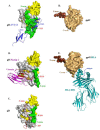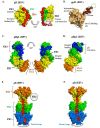Herpes virus fusion and entry: a story with many characters
- PMID: 22754650
- PMCID: PMC3386629
- DOI: 10.3390/v4050800
Herpes virus fusion and entry: a story with many characters
Abstract
Herpesviridae comprise a large family of enveloped DNA viruses all of whom employ orthologs of the same three glycoproteins, gB, gH and gL. Additionally, herpesviruses often employ accessory proteins to bind receptors and/or bind the heterodimer gH/gL or even to determine cell tropism. Sorting out how these proteins function has been resolved to a large extent by structural biology coupled with supporting biochemical and biologic evidence. Together with the G protein of vesicular stomatitis virus, gB is a charter member of the Class III fusion proteins. Unlike VSV G, gB only functions when partnered with gH/gL. However, gH/gL does not resemble any known viral fusion protein and there is evidence that its function is to upregulate the fusogenic activity of gB. In the case of herpes simplex virus, gH/gL itself is upregulated into an active state by the conformational change that occurs when gD, the receptor binding protein, binds one of its receptors. In this review we focus primarily on prototypes of the three subfamilies of herpesviruses. We will present our model for how herpes simplex virus (HSV) regulates fusion in series of highly regulated steps. Our model highlights what is known and also provides a framework to address mechanistic questions about fusion by HSV and herpesviruses in general.
Keywords: CMV; EBV; HSV; VZV; crystal structure; functional region; glycoproteins; monoclonal antibody.
Figures





Similar articles
-
Characterization of Vesicular Stomatitis Virus Pseudotypes Bearing Essential Entry Glycoproteins gB, gD, gH, and gL of Herpes Simplex Virus 1.J Virol. 2016 Oct 28;90(22):10321-10328. doi: 10.1128/JVI.01714-16. Print 2016 Nov 15. J Virol. 2016. PMID: 27605677 Free PMC article.
-
Functional Characterization of Glycoprotein H Chimeras Composed of Conserved Domains of the Pseudorabies Virus and Herpes Simplex Virus 1 Homologs.J Virol. 2015 Oct 21;90(1):421-32. doi: 10.1128/JVI.01985-15. Print 2016 Jan 1. J Virol. 2015. PMID: 26491153 Free PMC article.
-
A Functional Interaction between Herpes Simplex Virus 1 Glycoprotein gH/gL Domains I and II and gD Is Defined by Using Alphaherpesvirus gH and gL Chimeras.J Virol. 2015 Jul;89(14):7159-69. doi: 10.1128/JVI.00740-15. Epub 2015 Apr 29. J Virol. 2015. PMID: 25926636 Free PMC article.
-
The COMPLEXity in herpesvirus entry.Curr Opin Virol. 2017 Jun;24:97-104. doi: 10.1016/j.coviro.2017.04.006. Epub 2017 May 21. Curr Opin Virol. 2017. PMID: 28538165 Free PMC article. Review.
-
Well Put Together-A Guide to Accessorizing with the Herpesvirus gH/gL Complexes.Viruses. 2022 Jan 30;14(2):296. doi: 10.3390/v14020296. Viruses. 2022. PMID: 35215889 Free PMC article. Review.
Cited by
-
Frontiers in Suicide Gene Therapy of Cancer.J Genet Syndr Gene Ther. 2012 Oct 22;2012(3):e114. doi: 10.4172/2157-7412.1000e114. J Genet Syndr Gene Ther. 2012. PMID: 23330070 Free PMC article.
-
Nuclear Exodus: Herpesviruses Lead the Way.Annu Rev Virol. 2016 Sep 29;3(1):387-409. doi: 10.1146/annurev-virology-110615-042215. Epub 2016 Jul 22. Annu Rev Virol. 2016. PMID: 27482898 Free PMC article.
-
Characterization of Vesicular Stomatitis Virus Pseudotypes Bearing Essential Entry Glycoproteins gB, gD, gH, and gL of Herpes Simplex Virus 1.J Virol. 2016 Oct 28;90(22):10321-10328. doi: 10.1128/JVI.01714-16. Print 2016 Nov 15. J Virol. 2016. PMID: 27605677 Free PMC article.
-
Aptamers in Virology-A Consolidated Review of the Most Recent Advancements in Diagnosis and Therapy.Pharmaceutics. 2021 Oct 9;13(10):1646. doi: 10.3390/pharmaceutics13101646. Pharmaceutics. 2021. PMID: 34683938 Free PMC article. Review.
-
Molecular characterization and antiapoptotic function analysis of the duck plague virus Us5 gene.Sci Rep. 2019 Mar 19;9(1):4851. doi: 10.1038/s41598-019-41311-0. Sci Rep. 2019. PMID: 30890748 Free PMC article.
References
-
- Campadelli-Fiume G., Menotti L. Entry of Alphaherpesviruses into the Cell. In: Arvin A., Campadelli-Fiume G., Mocarski E., Moore P.S., Roizman B., Whitley R., Yamanishi K., editors. Source Human Herpesviruses: Biology, Therapy, and Immunoprophylaxis. Cambridge University Press; Cambridge, UK: 2007. Chapter 7. - PubMed
-
- Campadelli-Fiume G., Menotti L., Avitabile E., Gianni T. Viral and cellular contributions to herpes simplex virus entry into the cell. Curr. Opin. Virol. 2012;2:28–36. - PubMed
Publication types
MeSH terms
Substances
Grants and funding
LinkOut - more resources
Full Text Sources
Other Literature Sources

